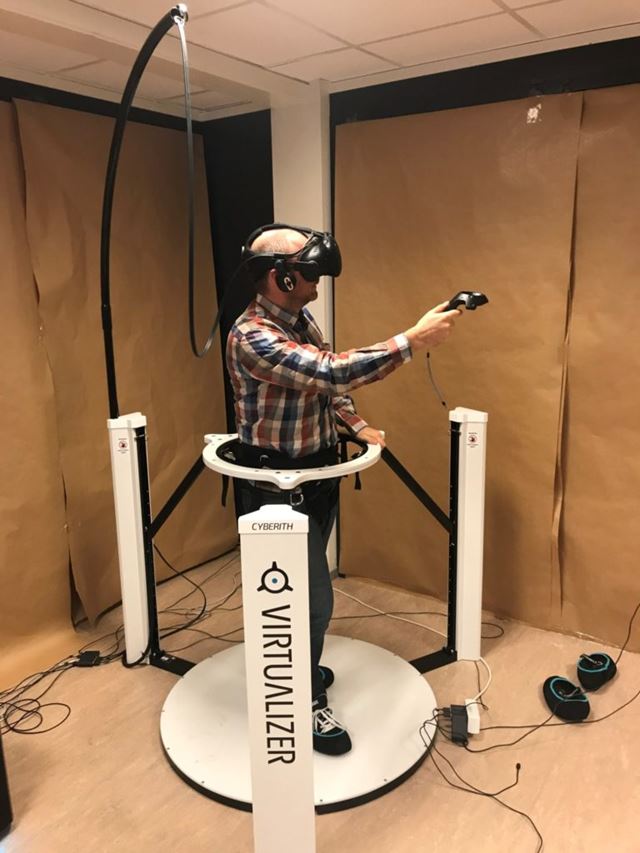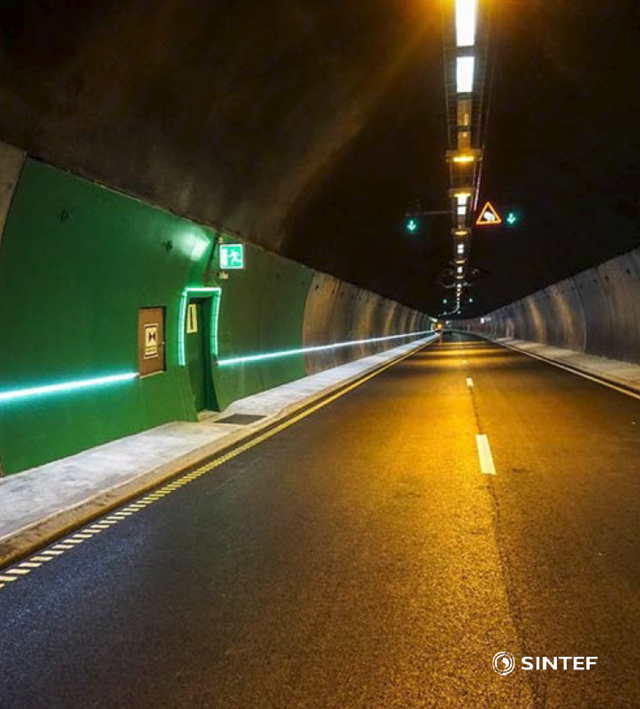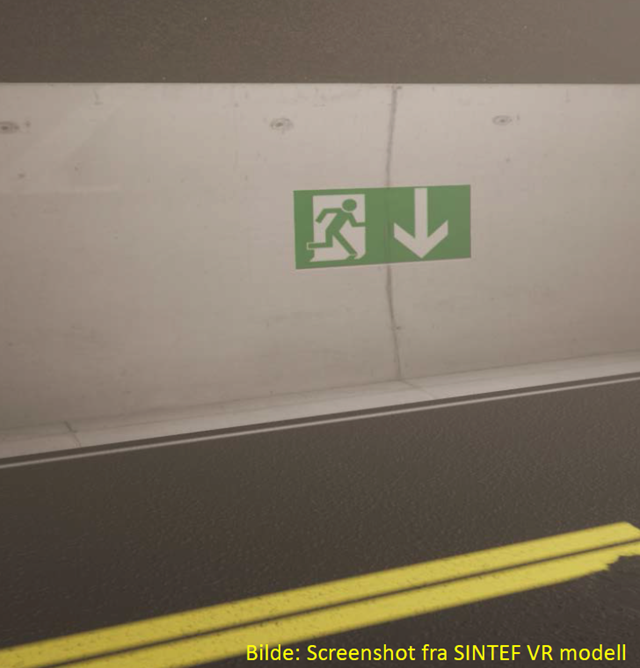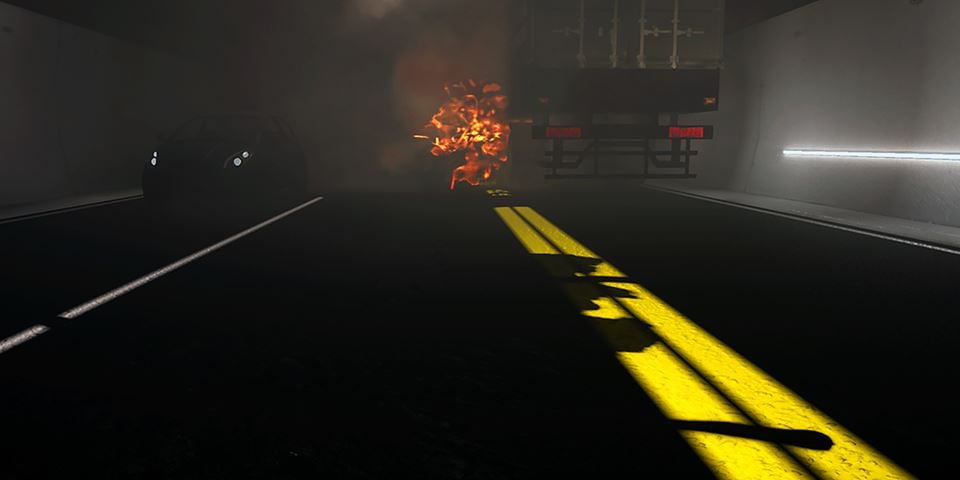“A cloud of smoke rushed towards me at tremendous speed”, says SINTEF researcher Gunnar Jenssen. “It took only a few seconds for the smoke to form a black carpet around my ankles. Then everything went black. Being trapped in a tunnel fire is a nightmare. It’s so frightening that most people become paralysed and unable to act”, he says.

Researcher Jo Skjermo demonstrates the willing VR equipment that was used during the trials, despite the fact that the lab was undergoing rebuilding when the picture was taken. Photo: SINTEF
To put you at ease, this terrible experience happened during a demonstration of the research methodology being applied as part of the project “Tunnel Evacuation” (Evakuering i tunnel) being carried out by SINTEF and the Norwegian Public Roads Agency (NPRA).
“There are two common reactions – fight or flight”, says Jenssen.
According to the Norwegian Accident Investigation Board, more than half of those caught in the Gudvanga tunnel fire in 2013 chose to remain in their cars rather than try to escape. This indicates that better evacuation and rescue aids are essential if lives are to be saved.
During the last seven years we’ve experienced six major and serious tunnel fires in Norway, without any loss of life”, says Jenssen. “But this is down to pure luck, and luck is often a factor when we talk about tunnel safety”, he says.
Virtual Reality research
Using software with near-reality graphics, VR glasses and a platform that records people’s movements, researchers from SINTEF and Lund University have together tested 80 subjects as part of a virtual, but rather credible, fire exercise.
Tackling a tunnel fire is a demanding task for the emergency services. Even experienced smoke divers may encounter problems finding their way in a fire situation. Research Scientist Gunnar Jenssen at SINTEF.
“Our work has included recreating realistic visibility conditions in black smoke”, says Jenssen. “This has never been done before. Using black smoke is important because it enables us to address issues related to visibility, and identify what we need to help people trapped in fires of this kind, who can hardly see their hands in front of their faces”, he explains.
The results have provided us with knowledge about how we behave during tunnel fires, and how we respond when we try to get to safety.
“The main aim of the project is to test and document the effect of tunnel “guidance” systems, such as signage, guide lights and loudspeakers”, says SINTEF researcher Jo Skjermo, who is responsible for the technical aspects of the VR project.
“The NPRA will also use the results to prepare a general information campaign designed to generate greater awareness about this topic”, he says.
Act fast
One thing that the researchers are sure about is that during a tunnel fire we will probably not have much time to act. A fire can accelerate rapidly, in some cases lightning fast, especially if fuel or other flammable haulage loads are involved.
The researchers also know that we tend to fumble around. We become unsure of ourselves and, not least, we walk around in circles. We intuitively follow the tunnel walls in our attempts to find a way out. But, unless we are given some directional guidance, it may be entirely a matter of chance whether we walk further into the tunnel rather than towards the exit. In the worst case, seconds may mean the difference between life and death.
“If the guidance system is inadequate, some people will walk towards the fire instead of away from it”, says Jenssen.
“It also takes time for the emergency services to arrive”, he says. “And when the rescue teams are in place, tackling tunnel fires is a demanding task. Even experienced smoke divers can experience problems finding their way in a fire situation”, he explains.
This is why it is important to be able to save ourselves. But what has to happen for us to achieve this?
Do safety measures work as well as we think?
As part of the behavioural study, the researchers investigated how we respond to a variety of safety measures. The aim was to get people out of the tunnel or into emergency refuge rooms in those tunnels that have them. Refuge rooms are not standard in Norwegian tunnels, but their use has been part of the study.
The safety measures tested as part of this project were as follows:
- Visual guide lights to help you out
- Audio aids (announcements from loudspeakers in several languages at the emergency exits)
- Signage at emergency exits indicating the location of guide lights
- The significance of the distance between emergency exits
Lights – but not at the end of the tunnel
Both the experiments and previous experience indicate that most people find a wall to follow.
“The problem is that there’s a fifty per cent chance that it will be the wrong wall”, says Jenssen. “And many people lose their sense of direction”, he says.
Rescue can be made easy by installing strip lighting at hip height along the walls. This enabled most subjects to find the wall and their way out.
(The article continues below the picture).

Lights at hip height were of great help, and is a measure the researchers now recommend that we use. No one walked past the door of the rescue room as long as there was a spotlight on the wall.
No-one walked past the refuge room door provided there was a guide light mounted on the wall.
“We also observed that people actually walked faster when they were guided by the strip lighting”, says Jenssen.
What is the ideal distance between emergency exits?
The distance to the nearest refuge room proved to be a crucial factor. If it was a long way, up to 500 metres, many people became unsure of themselves and began fumbling about.
Many turned around and started walking towards the fire instead of away from it.
Moreover, the knowledge that refuge rooms were built on both sides of the tunnel caused many of the subjects to try to find the other side.
The distance to the refuge room proved to be very important. When it was increased from 250 to 500 metres, subjects took four times as long to reach safety (from two to eight minutes).
Confusing signage

Dette skiltet forteller at nødutgangen befinner seg på motsatt side av tunnelen. Men det var det ingen av de 80 forsøkspersonene som forsto.
The researchers also made some interesting findings about signage. These included the fact that few of the subjects understood the meaning of the sign that tells you that the emergency exit is on the opposite side of the tunnel (see picture).
It was also impossible to read signs if the smoke was black. Visibility dropped rapidly to only 50 centimetres. This proved to be a problem in situations where two signs are mounted close together – one saying that there is 150 metres to the nearest emergency exit in one direction, the other indicating 100 metres in the opposite direction.
“People seem to try to find safety behind every door”, says Skjermo. “Twenty per cent of subjects tried to open the door to the technical room, which was always locked. This was identical to behaviour observed during previous tunnel fires. People have been found hiding behind concrete structures and squeezed into telephone booths”, he says.
The researchers conclude with the following clear recommendations:
- Norwegian tunnels should be installed with strip lighting, mounted approximately one metre from the floor. The aim of this is to provide the shortest possible visual distance.
- With tourists and foreign haulage drivers in mind, loudspeakers should be installed to provide multilingual announcements directing people to the nearest emergency exit.
- If refuge rooms are constructed, they should be located no more than 250 metres apart if they are to be effective. If a tunnel is prone to heavy traffic, an even shorter distance should be considered.
The Norwegian Public Roads Administration was SINTEF’s client for this project.



